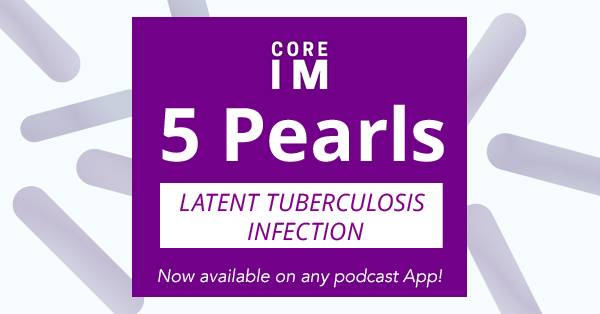Podcast: Play in new window | Download
Subscribe: RSS
By Raphael Rabinowitz MD, Viren Kaul MD, Marty Fried MD, Shreya Trivedi MD; Illustration by Ramon Thompson. Quiz yourself on the 5 Pearls we will be covering:
- Who should be screened for latent tuberculosis infection (LTBI)? (1:45)
- What screening tests are available and how do they differ? (6:30)
- What are the LTBI treatment options available? (10:24)
- What are the major adverse drug effects to consider? (13:28)
- How frequently should you check liver function tests in a patient being treated for LTBI? What do you do with the results? 17:43
- Dr. Caplan-Shaw Recap (21:29)
A special thank you to Dr. Caralee E. Caplan-Shaw for peer-reviewing this podcast!
Subscribe to CORE IM on any podcast app! Follow us on Facebook @Core IM || Twitter @COREIMpodcast || Instagram @core.im.podcast. Please give any feedback at COREIMpodcast@gmail.com.
Show notes
Pearl #1: Screening for TB
- In 2016 the USPSTF updated their latent tuberculosis screening recommendation to include screen all asymptomatic adults at increased risk of TB for LTBI. This includes 3 main groups:
- Close contacts of a person with active tuberculosis
- Those at high risk for exposure including individuals with:
- Contact with prisons (employees and prisoners)
- Hospital and residential rehabilitation center employees
- Homeless shelter residents or employees
- Mycobacterial lab personnel
- Current or previous residents in highly endemic areas, regardless of length of stay in non-endemic country such as U.S.
- Not included in this guideline are immunocompromised groups such as HIV-infected patients, those receiving chemotherapy, immunotherapy and post-transplant patients. Don’t forget about diabetic patients as immunocompromised!
Pearl #2: Latent Tuberculosis Screening Tests
- There are two categories of screening test: tuberculin skin tests (TSTs) and interferon gamma release assays (IGRAs).
- TST, for example the purified protein derivative (PPD) test, are inexpensive.
- Because of antigen cross-reactivity, the TST may be falsely positive in patients who have received the BCG vaccine.
- If the BCG vaccine was given within the 1st year of life, the effects wane over time, especially if the TST is done greater than 10 years post vaccination.
- Also limiting utility is the need for test evaluation 48-36 hours post-injection.
- Interferon Gamma Release Assays or IGRAs (for example, QuantiFERON-TB in-tube test) are preferred as it requires only a single visit and has higher specificity in BCG-vaccinated patients.
Pearl #3: Treatment for Latent Tuberculosis
- There are several regimens currently approved by CDC:
- Isoniazid i.e INH daily for 9 months
- Rifampin (RMP) daily for 4 months
- Combined INH / rifapentine (RPT) weekly for 12 weeks under directly observed therapy (DOT)
- Rifamycin-containing regimens have the advantage of shorter treatment periods, improved adherence, and fewer adverse drug events.
Pearl #4: Adverse effects of Latent Tuberculosis Therapies
- Hepatotoxicity is the major adverse drug event of LTBI treatments.
- Rifamycin-based regimens have lower risk than INH.
- Rifamycins are potent cytochrome P450 inducers. Many important medication classes will have decreased efficacy and need dose adjustment when on rifamycins.
- These include warfarin, methadone, many antiepileptics and oral contraceptive pills.
- These include warfarin, methadone, many antiepileptics and oral contraceptive pills.
Pearl #5: Liver Function Test Follow-up for Patients on Latent Tuberculosis Treatment
- 2007 ATS guidelines recommend NOT checking LFTs in asymptomatic patients.
- Baseline and follow-up LFTs should be checked in patients with chronic liver disease, chronic alcohol use, co-treatment with HAART, pregnant patients and any other risk for hepatotoxicity.
- Follow-up interval is generally every 2-4 weeks depending on co-morbid condition.
- Remember that ALT is the preferred test for detecting hepatocellular injury.
- Treatment should be held if ALT is more than 3x upper limit of normal in patients with symptoms (abdominal pain, jaundice, nausea/vomiting) or more than 5x upper limit of normal in asymptomatic patients.
References
- Bibbins-Domingo, K., Grossman, D. C., Curry, S. J., Bauman, L., Davidson, K. W., Epling, J. W., … & Kurth, A. E. (2016). Screening for latent tuberculosis infection in adults: US Preventive Services Task Force recommendation statement. Jama, 316(9), 962-969.
- Patel, S. et al.Risk of Progression to Active Tuberculosis Among Foreign-Born Persons With Latent Tuberculosis. Chest131,1811–1816 (2007).
- Targeted Tuberculin Testing and Treatment of Latent Tuberculosis Infection. American Journal of Respiratory and Critical Care Medicine161,(2000).
- Getahun, H., Matteelli, A., Chaisson, R. E. & Raviglione, M. Latent Mycobacterium tuberculosis Infection. New England Journal of Medicine 372,2127–2135 (2015).
- Lewinsohn, D. M. et al.Official American Thoracic Society/Infectious Diseases Society of America/Centers for Disease Control and Prevention Clinical Practice Guidelines: Diagnosis of Tuberculosis in Adults and Children. Clinical Infectious Diseases 64,111–115 (2017).
- Smieja, M., Marchetti, C., Cook, D. & Smaill, F. M. Isoniazid for preventing tuberculosis in non-HIV infected persons. Cochrane Database of Systematic Reviews(1999). doi:10.1002/14651858.cd001363
- Sterling, T. R. et al.Three Months of Rifapentine and Isoniazid for Latent Tuberculosis Infection. New England Journal of Medicine365,2155–2166 (2011).
- Stagg, H. R. et al.Treatment of Latent Tuberculosis Infection. Annals of Internal Medicine161,419 (2014).
- Menzies, D. et al.Adverse Events with 4 Months of Rifampin Therapy or 9 Months of Isoniazid Therapy for Latent Tuberculosis Infection. Annals of Internal Medicine149,689 (2008).
- Saukkonen, J. J. et al.An Official ATS Statement: Hepatotoxicity of Antituberculosis Therapy. American Journal of Respiratory and Critical Care Medicine174,935–952 (2006).

